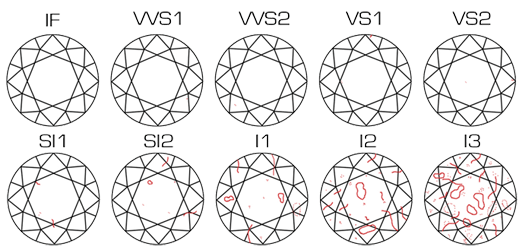Hyrv presents the superior quality standards of Loose Natural Diamonds. We offer wide collection of exquisitely cut diamonds, selected for the finest quality, color, and clarity.
Certificate of quality
A grading measure reports from GIA, HRD or IGI, independent diamond grading laboratories with the highest standards, are attached to each loose diamond we possess.

Our certified diamonds are graded by GIA, HRD or IGI to feature FL-SI2 clarity, D-J Colors, and Ideal, Very Good, Good, or Fair cut.
Your Diamond Shape
Since all diamond shapes are very different, unique characteristics determine quality for each shape. Select your shape below to learn how to recognize the most beautiful diamond. If you have additional questions, feel free to contact us, we can help you find the diamond that’s perfect for you.
Your Diamond Cut
The cut of a diamond characterizes the manner in which a diamond has been shaped. Primarily, diamond cut depends on the shape of the original rough stone.
Quality cut control of each diamond shape determines the workmanship art, proportions, symmetry of angles, and surface.
The shape of the diamond is mainly described in the name of the shape (primarily the view from the top).
Although, all diamond shapes have various characteristics, the choice mostly depends on a personal taste and also influenced by a fashion.

Your Diamond Color
Hyrv offers the finest diamonds, color grade “D-J”.
The finest color quality is Colorless; it is graded as “D”.
The next grade has a color trace, which is typically undetectable to the unaided eye, but can be seen by an expert.
Diamonds with a slight trace of color are graded as “G” or “H” (Near Colorless).
Slightly tinted diamonds are graded “I” or “J” or “K.
Colors in diamond depend on crystal structural defects and impurities. Each colored diamond is a unique piece. There are rare color diamonds: pink, blue, green and even red.

The Choice
If you are looking for the purist diamond, then you should choose between colorless diamonds of D-F grade.
But if you valuate diamonds with slightly or almost unnoticeable color to the unaided eye, choose grade G-I.
The Clarity
Clarity classifies imperfections that occur in all diamonds except the finest ones. To be short and sweet and avoid the technical terms gemologists use to classify these imperfections- diamonds with the least imperfections get the high-level clarity grades.

Your Diamond Weight
Diamond’s weight means carat weight. To obtain a correct understanding of diamond size, Hyrv suggests to consider carat weight with two basic characteristics:
the distance across the top of the diamond measured in millimeters, and 2) the diamond’s cut grade.
Download the diamond size chart
It is important to measure the distance across the top of the diamond as this is how we view a stone when set into a ring.
A diamond’s cut grade should also be considered because, as we noted in the cut grade section, when a diamond is cut with the proper proportions, the maximum amount of light (or sparkle) is returned out of the top of the diamond. Thus, when a diamond is well cut, the light reflected out of the top makes it appear larger. In addition, much of the weight of a poorly cut diamond, for example, may be “hidden” in the base of the diamond, making the diamond appear smaller than its carat weight would imply.
It is therefore possible to have a diamond of a lower carat weight, but higher cut grade, that appears larger than a diamond with a larger carat weight, but poor cut.
Once you’ve selected your cut, color, and clarity grade, it’s easy to determine the carat weight of diamond that will fit within your budget.
Cleaning & Servicing Your Diamond
It is important to measure the distance across the top of the diamond because this is how a stone is set into a ring.
A diamond’s cut grade should be taken into account because, when a diamond is cut with the excellent proportions, the greatest amount of light (or sparkle) is returned out of the top of the diamond and the light reflected makes it look larger. On the other hand, poorly cut diamond’s weight may “disappear” in the base, making it look smaller than its carat weight would show.
Therefore it is possible to have lower carat weight diamond of a higher cut grade, that looks larger than poorly cut diamond of a larger carat.
Cleaning & Servicing
We recommend cleaning your diamonds professionally once every six months since environmental (dirt, dust, chemicals etc.) and personal (makeup, perspiration etc.) factors affect your precious stones natural beauty.

